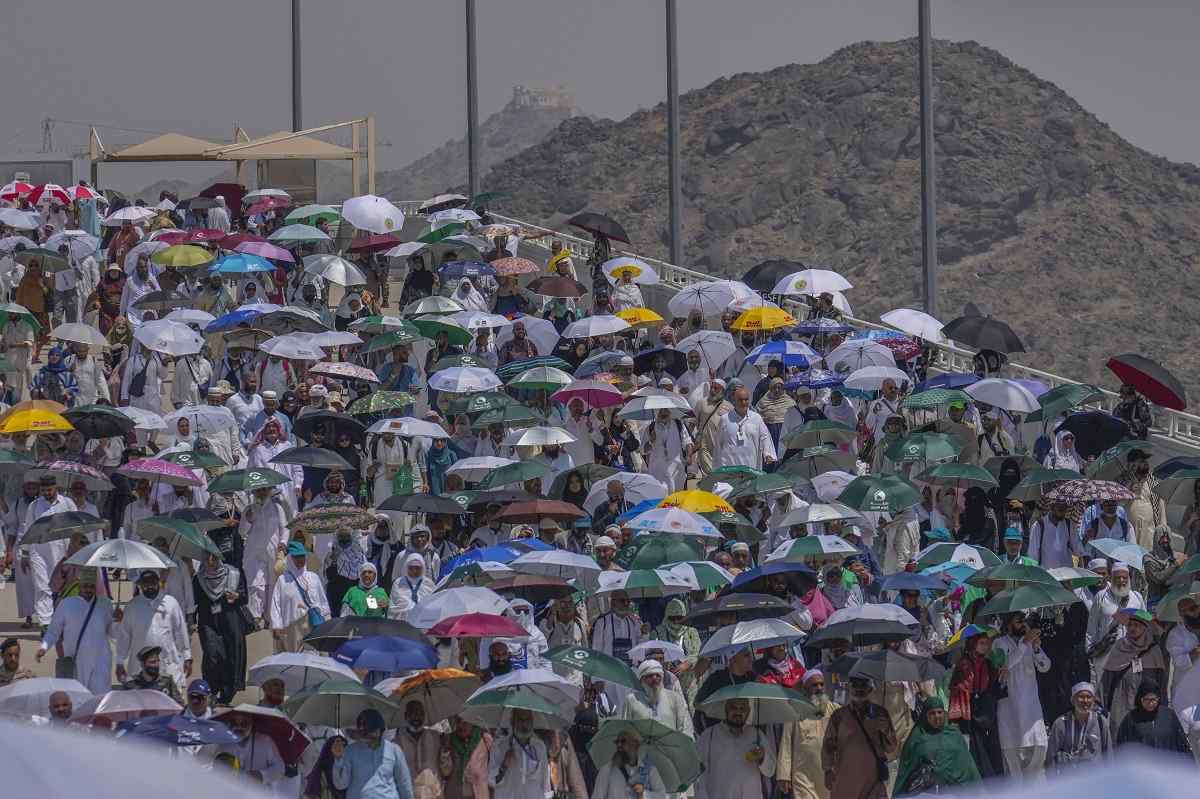Hundreds Died during This Year’s Hajj Pilgrimage in Saudi Arabia amid Intense Heat, Officials Say

Muslim pilgrims use umbrellas to shield themselves from the sun as they arrive to cast stones at pillars in the symbolic stoning of the devil, the last rite of the annual hajj, in Mina, near the holy city of Mecca, Saudi Arabia, Tuesday, June 18, 2024.
11:22 JST, June 20, 2024
MECCA, Saudi Arabia (AP) — Hundreds of people died during this year’s Hajj pilgrimage in Saudi Arabia as the faithful faced intense high temperatures at Islamic holy sites in the desert kingdom, officials said Wednesday as people tried to claim their loved ones’ bodies.
Saudi Arabia has not commented on the death toll amid the heat during the pilgrimage, required of every able Muslim once in their life, nor offered any causes for those who died. However, hundreds of people had lined up at the Emergency Complex in Al-Muaisem neighborhood in Mecca, trying to get information about their missing family members.
One list circulating online suggested at least 550 people died during the five-day Hajj. A medic who spoke to The Associated Press on condition of anonymity to discuss information not released publicly by the government said that the names listed appeared genuine. That medic and another official who also spoke on condition of anonymity for the same reason said they believed at least 600 bodies were at the facility.
Deaths are not uncommon at the Hajj, which has seen at times over 2 million people travel to Saudi Arabia. There have also been stampedes and epidemics through the pilgrimage’s history.
Each year, the Hajj draws hundreds of thousands of pilgrims from low-income nations, “many of whom have had little, if any, pre-Hajj health care,” according to an article in the April edition of the Journal of Infection and Public Health. Communicable illnesses can spread among the gathered masses, many of whom save their entire lives for the pilgrimage and can be elderly with preexisting health conditions, it said.
However, the number of dead this year suggests something caused the fatalities to swell. Already, several countries have said some of their pilgrims died because of the heat that swept across the holy sites at Mecca, including Jordan and Tunisia.
Khalid Bashir Bazaz, an Indian pilgrim, speaking near the Grand Mosque on Wednesday, said he “saw a lot of people collapsing to the ground unconscious” during this year’s Hajj.
Temperatures on Tuesday reached 47 degrees Celsius (117 degrees Fahrenheit) in Mecca and the sacred sites in and around the city, according to the Saudi National Center for Meteorology. Some people fainted while trying to perform the symbolic stoning of the devil.
Many Egyptians said they lost track of their loved ones in the heat and the crowds. More than 1.83 million Muslims performed the Hajj in 2024, including more than 1.6 million from 22 countries, and around 222,000 Saudi citizens and residents, according to the Saudi Hajj authorities.
On Wednesday at the medical complex in Mecca, an Egyptian man broke down when he heard his mother was among the dead. He cried for some time before grabbing his cellphone and calling their travel agent.
“He left her to die,” he shouted, referring to the agent. The crowd tried to calm him down.
Security appeared tight at the complex, with an official reading out names of the dead and the nationalities, which included people from Algeria, Egypt and India. Those who said they were kin of the dead were allowed inside to identify the deceased.
The AP could not independently confirm the causes of death for the people whose bodies were held at the complex. Saudi officials did not respond to questions seeking more information.
The kingdom’s ruling Al Saud family maintains a major influence in the Muslim world through its oil wealth and management of Islam’s holiest sites. Like Saudi monarchs before him, King Salman has taken the title of the Custodian of the Two Holy Mosques, referring to the Grand Mosque in Mecca, home to the cube-shaped Kaaba that Muslims pray towards five times a day, and the Prophet’s Mosque in the nearby city of Medina.
Saudi Arabia has spent billions of dollars on crowd control and safety measures for those attending the annual five-day pilgrimage, but the sheer number of participants makes ensuring their safety difficult.
Climate change could make the risk even greater. A 2019 study by experts at the Massachusetts Institute of Technology found that even if the world succeeds in mitigating the worst effects of climate change, the Hajj would be held in temperatures exceeding an “extreme danger threshold” from 2047 to 2052, and from 2079 to 2086.
Islam follows a lunar calendar, so the Hajj falls around 11 days earlier each year. By 2029, the Hajj will occur in April, and in the next several years after that it will fall in the winter, when temperatures are milder.
A 2015 stampede in Mina during the hajj killed over 2,400 pilgrims, the deadliest incident to ever strike the pilgrimage, according to an AP count. Saudi Arabia has never acknowledged the full toll of the stampede. A separate crane collapse at Mecca’s Grand Mosque, which preceded the Mina disaster that same year, killed 111 people.
The second-deadliest incident at hajj was a 1990 stampede that killed 1,426 people.
"News Services" POPULAR ARTICLE
-

American Playwright Jeremy O. Harris Arrested in Japan on Alleged Drug Smuggling
-

Japan’s Nikkei Stock Average as JGB Yields, Yen Rise on Rate-Hike Bets
-

Japan’s Nikkei Stock Average Licks Wounds after Selloff Sparked by BOJ Hike Bets (UPDATE 1)
-

Japanese Bond Yields Zoom, Stocks Slide as Rate Hike Looms
-

Japan’s Nikkei Stock Average Buoyed by Stable Yen; SoftBank’s Slide Caps Gains (UPDATE 1)
JN ACCESS RANKING
-

Keidanren Chairman Yoshinobu Tsutsui Visits Kashiwazaki-Kariwa Nuclear Power Plant; Inspects New Emergency Safety System
-

Imports of Rare Earths from China Facing Delays, May Be Caused by Deterioration of Japan-China Relations
-

University of Tokyo Professor Discusses Japanese Economic Security in Interview Ahead of Forum
-

Japan Pulls out of Vietnam Nuclear Project, Complicating Hanoi’s Power Plans
-

Govt Aims to Expand NISA Program Lineup, Abolish Age Restriction



























